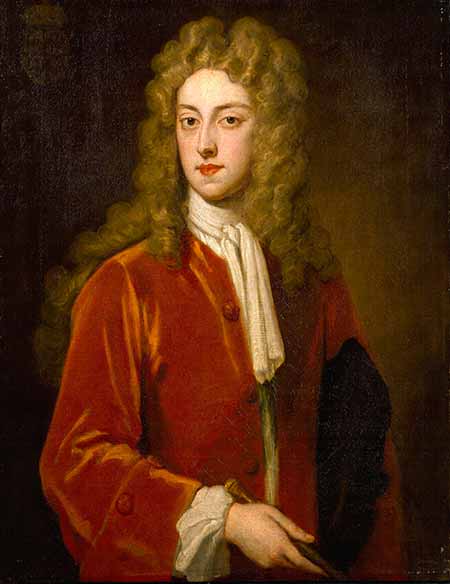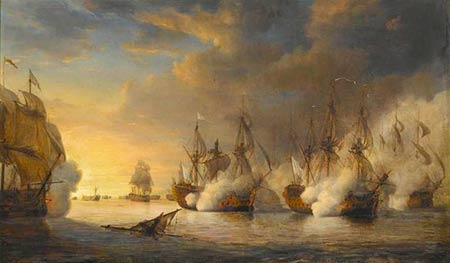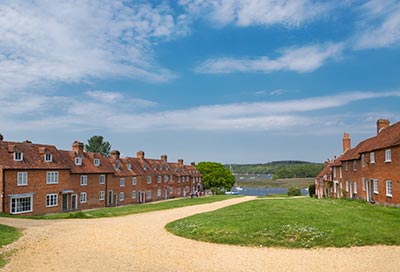Montagu Town and the early years of shipbuilding
Buckler's Hard was possibly originally named after the Buckle family, who had been resident locally since at least 1668.
The suffix 'Hard' was added, as is the case elsewhere on the south coast, to signify 'a natural, firm landing place'.
The Buckles, however, were not involved in the development of the site.
(1) Montagu Town
In the early 1720s, John, 2nd Duke of Montagu, devised a plan to use Buckler's Hard as the location for a port and refinery for sugar brought in from West Indian plantations then in the Duke's possession.
The port was to be known as Montagu Town.

Accordingly, what was previously just a landing place without houses, wharves or other items of infrastructure; was cleared of trees, a smooth slope was created leading down to the river and a quay constructed.
The 'new town' to some extent was planned as we see it today and included two sets of cottages, some thatched, running down to the shore, separated by a wide grassy street suitable for use as a general concourse and also as a site for markets and fairs.
The cottages, however, were not originally in continuous terraces but rather were in blocks with gaps between - later additions have filled the gaps.
But, unfortunately for the Duke, even before construction of many of the cottages was completed, the venture failed after access was lost to the principal sources of sugar on the Caribbean islands of St. Lucia and St. Vincent; and the site eventually reverted to its previous, popularly used name: Buckler's Hard.
(2) War brings a fresh lease of life to the dormant 'new town'
Britain and France were officially at war during 65 of the 126 years between 1689 and 1815, and were hardly the best of friends during the other years. Spain and others, too, for much of this time were enemies of Britain and its allies.
This was, of course, not much fun for those killed or injured in battle, but it was certainly good news for shipwrights who were only too willing to build the wooden warships of the day and replace or patch up damaged or captured vessels.

After a period of relative calm, an upturn in hostilities in the late 1730s and early 1740s increased the need for warships beyond the royal dockyards capacity to meet the demand, and so contracts were placed with private shipbuilders.
Meanwhile, the buildings and infrastructure of what was to have been Montagu Town had lain largely unused until James Wyatt, a local entrepreneur, obtained a naval contract in 1744 to build the wooden hull of a 24-gun ship, the Surprise, and chose the site as the base for his shipyard.
It was a somewhat logical decision: the river was of suitable depth and width for shipbuilding and subsequent launching, and was sheltered from prevailing westerly winds: the new quay was in good repair: the wide street provided storage space for large timbers: there was an ironworks at nearby Sowley: and timber - primarily oak and elm - suitable for shipbuilding was available from the Duke of Montagu's estate - New Forest oaks were reserved for use in the royal dockyards.
Furthermore, Wyatt was already known to the Duke of Montagu, the Duke welcomed the prospect of activity returning to his 'new town', and was also keen to obtain rental income from the land and facilities.

In conjunction with John Major, a shipwright, Wyatt completed the Surprise, which was launched in 1745, before going on to build the hull of another naval vessel, the 18-gun Scorpion, launched in 1746.
However, for reasons that aren't entirely clear, Wyatt and Major withdrew from the shipbuilding trade and were succeeded at Buckler's Hard by John Darley, a Gosport shipwright who had obtained a contract to build a 44-gun ship, the Woolwich.
But following financial difficulties, Darley was unable to complete the Woolwich, and so Moody Janverin, a Hamble-based shipbuilder who at that time was building a ship at nearby Lepe, was asked to finish the work, which he did prior to the vessel's launch in 1749.
Janverin did not stay at Buckler's Hard, though, for Henry Adams, who was to be forever synonymous with shipbuilding on the Beaulieu River, took over the reigns from the financially stricken Darley.
Find out more about Buckler's Hard's fascinating history
References:
Bucklers Hard - a rural shipbuilding centre: A.J. Holland
An Album of Old Beaulieu: Susan Tomkins
Hampshire Place Names: Richard Coates
Historic England - Buckler's Hard
Beaulieu History Society Newsletter - Henry Adams: shipbuilder
Various Wikipedia pages
Quick links
More links
Other related links
Search this site

